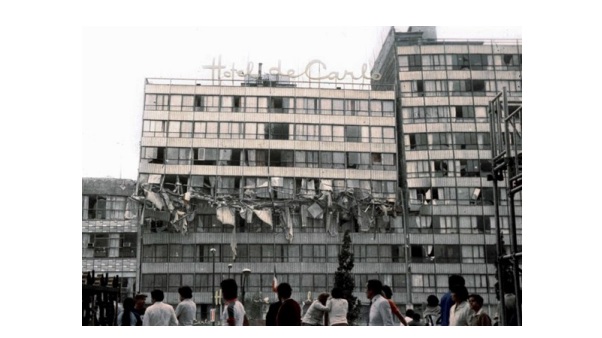Structural pounding in the seismic vulnerability of buildings located on soft soils
Keywords:
Seismic vulnerability, Structural pounding, Incremental Dynamic Analysis, Soft soilsAbstract
This study analyzes the effect of structural pounding on the nonlinear dynamic response of buildings located in the soft soil zone of Mexico City when subjected to seismic actions.To this end, the structural typologies to be studied were identified, and their behavior was evaluated through incremental dynamic analyses that is, nonlinear step-by-step analyses with a monotonic increase in seismic demand. The study was carried out using the OpenSees software, where nonlinear behavior due to lateral displacements was modeled using concentrated plasticity in the structural elements, employing the corresponding moment-curvature and moment-rotation diagrams.To represent the pounding phenomenon, a linear elastic contact-force model was used to simulate collisions between structures, assuming that contact occurs between the floor systems of adjacent buildings.The results obtained show that structural pounding has a significant impact on buildings, as it amplifies the seismic response and increases the interstory shear, which can lead to structural collapse. The information generated in this study is valuable for assessing the seismic structural vulnerability of buildings subjected to pounding and, if possible, for implementing preventive actions that help mitigate the associated risk.
Downloads
References
Anagnostopoulos, S. A. (1988). “Pounding of buildings in series during earthquakes”, Earthquake Engineering and Structural Dynamics, 16, pp. 443–456.
Anagnostopoulos, S., Spiliopoulos, K. (1992) “An investigation of earthquake induced pounding
between adjacent buildings”, Earthquake Engineering and Structural Dynamics, 21, pp. 289–302.
Almaraz, S. (2019) “Comportamiento sísmico de marcos de concreto reforzado con piso débil ante acciones de eventos de subducción y falla normal”, Tesis licenciatura, Facultad de Ingeniería, UNAM.
Cole, G., Dhakal, R., Carr, A. y Bull, D. (2010) “Building pounding state of the art: Identifying structures vulnerable to pounding damage”, 2010 NZSEE Conference.
Goland, M., Wickersham, P. y Dengler, M. (1955) “Propagation of elastic impact in beams in bending”, Journal of Applied Mechanics, 22, pp. 1-7.
Goldsmith, W. (1960) “The Theory and Physical Behavior of Colliding Solides”, Arnold, London, UK.
Hosseini, S., Naderpur, H., Vahdani, R. y Jankowski, R. (2021) “Evaluation of pounding effects between reinforced concrete frames subjected to far-field earthquakes in terms of damage index”, Bulletin of Earthquake Engineering, 20, pp. 1219-1245.
Jankowski, R. y Mahmoud, S. (2015) “Earthquake-Induced Structural Pounding”, Ed. Springer Cham.
McKenna, F., Fenves, G. y Scott. M. (2015) “Open system for earthquake engineering simulation”, University of California.
Naserkhaki, S. (2011) “Pounding between adjacent buildings in consideration of soil structure interaction”, Tesis de maestría, Universidad de Malasia.
Naserkhaki, S., Aziz, F. y Pourmohammad, H. (2012) “Earthquake induced pounding between adjacent buildings considering soil-structure interaction”, Earthquake Engineering and Engineering Vibration 11, pp. 343-358.
Ordaz, M., Miranda, E., Reinoso, E. y Pérez-Rocha L. (2000) “Seismic loss estimation model for Mexico City”, 12 World Conference on Earthquake Engineeering, 1902, pp. 1-8.
Park, Y., and Ang, A. (1985) “Mechanistic Seismic Damage Model for Reinforced Concrete”, Journal of Structural Engineering, 11 (4).
Rosenblueth, E. y Meli, R. (1986) “The 1985 earthquake: causes and effects in Mexico City”, Concrete International, 8, pp. 23-34.
Soltysik, B., Falborski, T. y Jankowski, R. (2017) “Preventing of earthquake-induced pounding between steel structures by using polymer elements – experimental study”, Procedia Engineering, 199, pp. 278-283.
Teran, G.A., Jirsa, J. (2005) A damage index for practical seismic design that accounts for low cyclefatigue. Earthquake Spectra, 21, 803-832.
Van Mier, J., Pruijssers, A., Reinhardt, H. y Monnier, T. (1991) “Load-time response of colliding concrete bodies”, Journal of Structural Engineering, 117 (2), pp. 354-374.
Vamvatsikos. D. y Cornell, C. (2002) “Incremental Dynamic Analysis” Earthquake Engineering & Structural Dynamics, 31 (3), pp. 491-514.

Downloads
Published
Versions
- 2025-06-30 (4)
- 2025-08-25 (3)
- 2025-06-30 (2)
- 2025-08-13 (1)
Issue
Section
License
Copyright (c) 2025 Revista Ingeniería y Tecnología UAS

This work is licensed under a Creative Commons Attribution-NoDerivatives 4.0 International License.

